Share this
a history of the VAMS concept
by James Rudge, PhD, Technical Director, Trajan on Feb 2, 2018 11:17:55 AM
In 2014, Neoteryx was spun off from its parent company, Phenomenex, to develop, manufacture, and sell Mitra® microsampling devices, based on Volumetric Absorptive Microsampling. The company's microsampling products are based on proprietary VAMS® technology. Here, co-inventor and Microsampling Technical Director James B. Rudge, PhD, shares the full story of how this volumetric microsampling breakthrough came to be.
Origin of the VAMS Concept
In 2008, while I was still working at Phenomenex, I attended the 30th BMSS meeting in York, England. During this meeting, I met with my friend Dr. Neil Spooner, who was working at GlaxoSmithKline in Ware, leading a team in the DMPK department looking at new technologies.
Neil’s focus at the time was developing quantitative PK studies from dried blood spot (DBS) cards. He mentioned that, although DBS showed great promise as a microsampling technique - ease of transport was a huge benefit to them - the technique had some technical limitations.
One DBS limitation was the volumetric hematocrit bias, and the second was controlling the volume added to the DBS cards. The way they overcame this was to volumetrically collect blood via a fixed volume capillary and carefully spot this onto a DBS card.
This was when the idea of VAMS dawned on me.
My father was diabetic and he had to test his blood sugars daily using a finger-prick and test strips, which take up a microsample of blood. These blood samples were analyzed using a small point-of-care device. Talking to Neil, I wondered aloud whether something like this could be developed as an alternative to DBS where the sampling device is easy to use and has a volumetric component to it. Neil said this sounded like a great idea, so I decided to develop some concepts for VAMS at home.
Developing the VAMS Concept
The first prototype I created involved taking DBS paper and fixing it in a holder. The idea of this was to apply the sampler to the blood and allow it to collect laterally.
This design proved to take up the blood too slowly. When I showed it to Neil and his colleague Phil Denniff, they said that they would prefer to see the DBS paper covered in some way.
The next concept was designed to build in a retractable functionality. It had a wedge-shaped design at the end to see if the flow of blood would stop at the tapered edge.
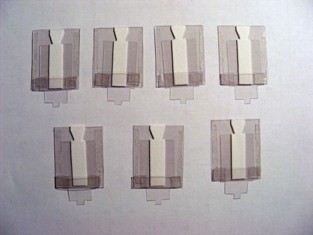
This was tested by Neil and Phil, and it worked! But, again, blood flow was too slow.
One issue associated with the design concepts I had created thus far was that there was no automation element. Pondering this, I realized that if I mounted a small amount of paper on the end of a pipette tip, this sampler could be easily automated.
My first attempt at doing this was to adapt a positive displacement pipettor with a post punch of a DBS disk mounted on the piston (see below).
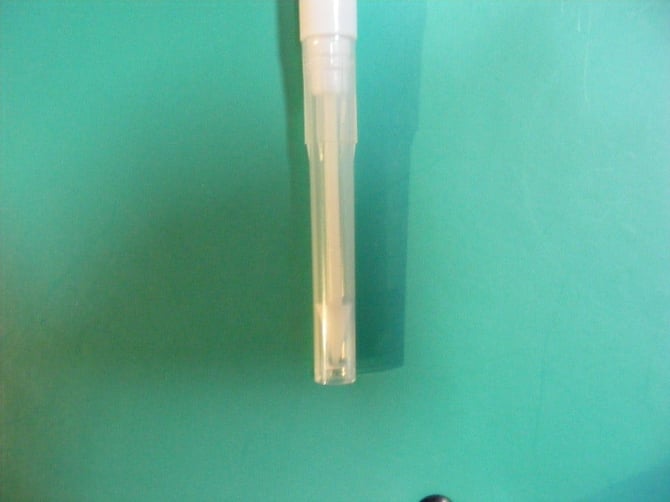
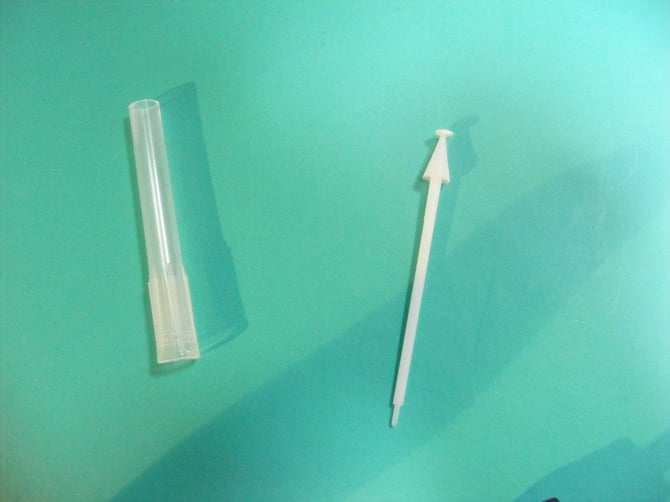
I felt that, although this would be an elegant design for the product, it was likely to be costly. So, I came up with the idea of mounting paper triangles onto standard pipette tips (see below).
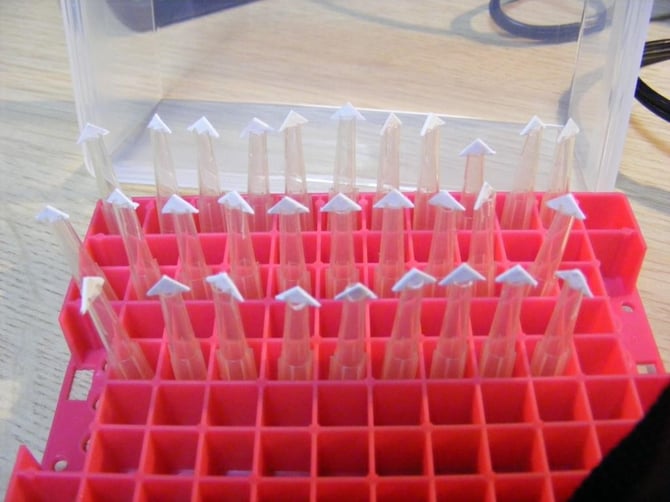
Shown here are 36 samplers that I took to GSK for testing by Neil and colleagues. At the Ware site, we looked to see if my VAMS prototype samplers absorbed a fixed volume of blood independent of hematocrit. We did some extraction studies, too.
The results indicated that these samplers had a volumetric component, and bias results showed that, rather than positive bias with respect to increasing hematocrit as observed for DBS, these showed a negative bias. It was hypothesized that this was due to hematocrit-dependent extraction bias, which could be solved with the right extraction conditions.
Neil encouraged me to present this idea to Phenomenex, as this concept had the potential to solve so many of the issues seen with DBS. How little we knew then!
An Inventor Visits the United States
In 2010, equipped with a presentation and my prototypes, I traveled from England to California to meet with the management team at Phenomenex to show them my blood sampling concept. Because of this, Phenomenex R&D were instructed by Fasha Mahjoor (CEO and owner - 1982-2016) to begin making the VAMS idea a reality.
From 2010-2014, development of the VAMS technique progressed. During this time, Phenomenex and GSK kept in close contact to share data and designs. We owe a huge debt of gratitude to Neil Spooner, Phil Denniff, and the GSK team for their valuable input and testing of prototypes.
Finally, in 2014, the first VAMS device was a reality and a sister company to Phenomenex was born.
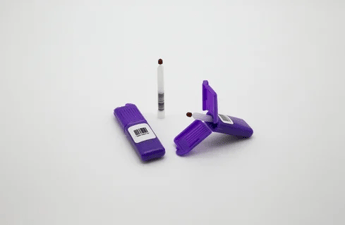 The new company was called Neoteryx, and their job was to launch the Mitra® microsampling device based on VAMS® technology. The Mitra device was launched at the ASMS meeting of that year.
The new company was called Neoteryx, and their job was to launch the Mitra® microsampling device based on VAMS® technology. The Mitra device was launched at the ASMS meeting of that year.
Since that time, Neoteryx has grown from strength to strength to become a world leader in the microsampling market, with many customers having deployed assays on the technology. In 2022, Neoteryx was acquired by Trajan Scientific and Medical. Trajan aims to expand the range of products and solutions sold under Neoteryx, its microsampling brand.
Words from An Early Collaborator
Since the pioneering days of the VAMS technique, I’ve remained great friends with Neil and Phil, and it seems only fitting to let Neil say the final words to close this history of the VAMS concept.
"The development of the Neoteryx blood sampler is a wonderful example of how you should never give up on an important issue, and how networking and honest conversations can solve difficult problems. Many observers thought that the DBS hematocrit and homogeneity issues were the end of the line for all the hopes we had invested in this novel approach and the tangible benefits it would deliver for high quality quantitative bioanalysis, patients and animal use. However, we knew there must be a solution to the challenge. We kept on talking. We kept on theorizing. We kept on dreaming. We kept on supporting and sharing. We kept on experimenting. The result? People listened. People got motivated. People invested time and money and delivered a viable workable solution. How wonderful is that?"
— Neil Spooner January 2018

Image Credits: Neoteryx, Trajan, James Rudge
Share this
- Microsampling (206)
- Research, Remote Research (119)
- Venipuncture Alternative (105)
- Clinical Trials, Clinical Research (83)
- Mitra® Device (73)
- Therapeutic Drug Monitoring, TDM (51)
- Dried Blood Spot, DBS (39)
- Biomonitoring, Health, Wellness (30)
- Infectious Disease, Vaccines, COVID-19 (24)
- Blood Microsampling, Serology (23)
- Omics, Multi-Omics (21)
- Decentralized Clinical Trial (DCT) (20)
- Specimen Collection (18)
- Toxicology, Doping, Drug/Alcohol Monitoring, PEth (17)
- Skin Microsampling, Microbiopsy (14)
- hemaPEN® Device (13)
- Preclinical Research, Animal Studies (12)
- Pharmaceuticals, Drug Development (9)
- Harpera Device (7)
- Industry News, Microsampling News (5)
- Antibodies, MAbs (3)
- Company Press Release, Product Press Release (3)
- Environmental Toxins, Exposures (1)
- July 2025 (1)
- May 2025 (1)
- April 2025 (2)
- December 2024 (2)
- November 2024 (1)
- October 2024 (3)
- September 2024 (1)
- June 2024 (1)
- May 2024 (1)
- April 2024 (4)
- March 2024 (1)
- February 2024 (2)
- January 2024 (4)
- December 2023 (3)
- November 2023 (3)
- October 2023 (3)
- September 2023 (3)
- July 2023 (3)
- June 2023 (2)
- April 2023 (2)
- March 2023 (2)
- February 2023 (2)
- January 2023 (3)
- December 2022 (2)
- November 2022 (3)
- October 2022 (4)
- September 2022 (3)
- August 2022 (5)
- July 2022 (2)
- June 2022 (2)
- May 2022 (4)
- April 2022 (3)
- March 2022 (3)
- February 2022 (4)
- January 2022 (5)
- December 2021 (3)
- November 2021 (5)
- October 2021 (3)
- September 2021 (3)
- August 2021 (4)
- July 2021 (4)
- June 2021 (4)
- May 2021 (4)
- April 2021 (3)
- March 2021 (5)
- February 2021 (4)
- January 2021 (4)
- December 2020 (3)
- November 2020 (5)
- October 2020 (4)
- September 2020 (3)
- August 2020 (3)
- July 2020 (6)
- June 2020 (4)
- May 2020 (4)
- April 2020 (3)
- March 2020 (6)
- February 2020 (3)
- January 2020 (4)
- December 2019 (5)
- November 2019 (4)
- October 2019 (2)
- September 2019 (4)
- August 2019 (4)
- July 2019 (3)
- June 2019 (7)
- May 2019 (6)
- April 2019 (5)
- March 2019 (6)
- February 2019 (5)
- January 2019 (8)
- December 2018 (3)
- November 2018 (4)
- October 2018 (7)
- September 2018 (6)
- August 2018 (5)
- July 2018 (8)
- June 2018 (6)
- May 2018 (5)
- April 2018 (6)
- March 2018 (4)
- February 2018 (6)
- January 2018 (4)
- December 2017 (2)
- November 2017 (3)
- October 2017 (2)
- September 2017 (4)
- August 2017 (2)
- July 2017 (4)
- June 2017 (5)
- May 2017 (6)
- April 2017 (6)
- March 2017 (5)
- February 2017 (4)
- January 2017 (1)
- July 2016 (3)
- May 2016 (1)
- April 2016 (2)

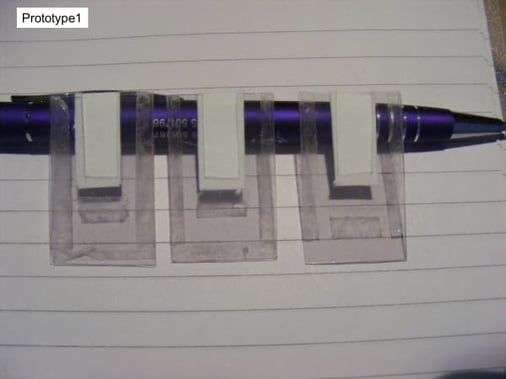

Comments (1)